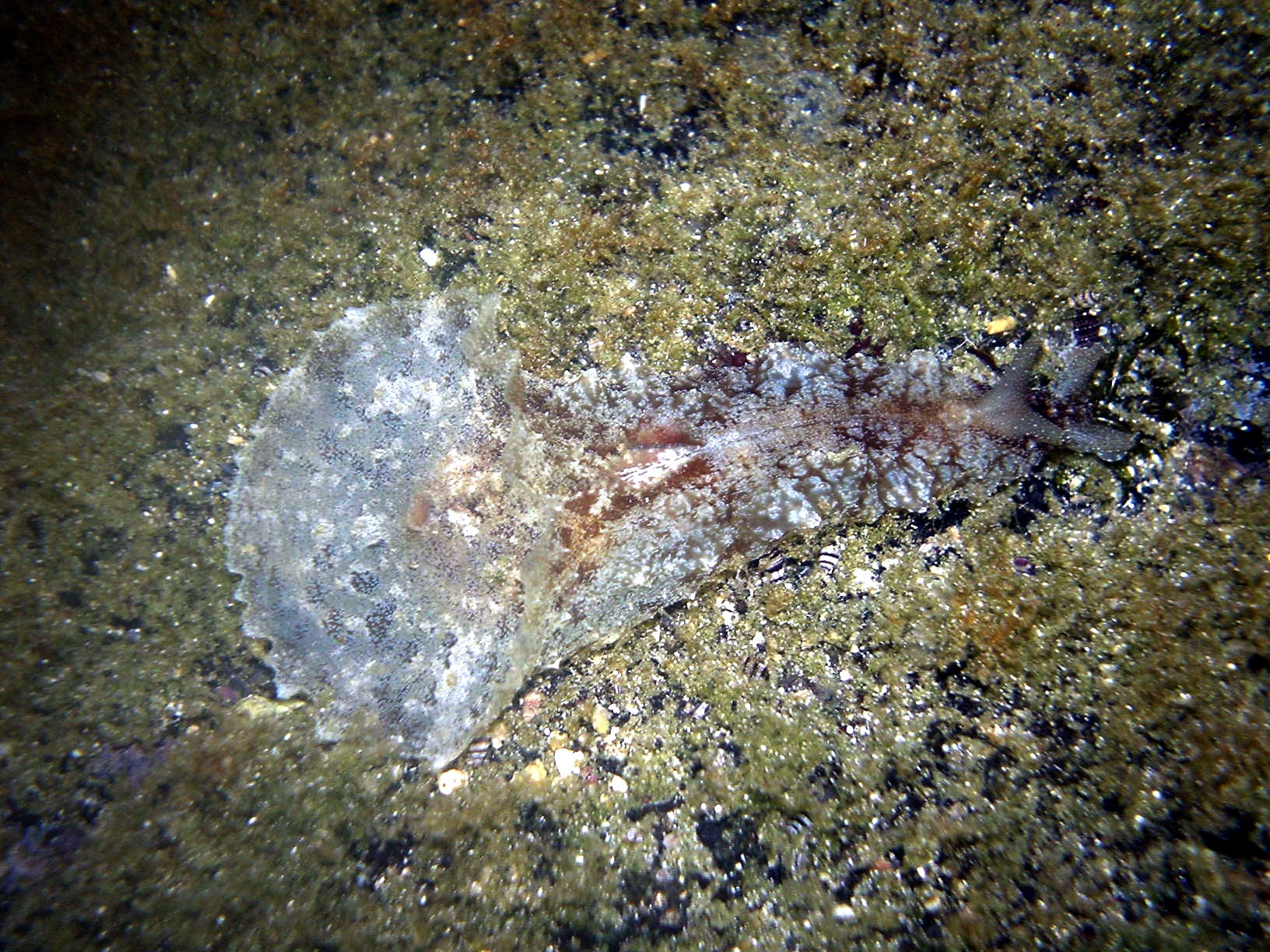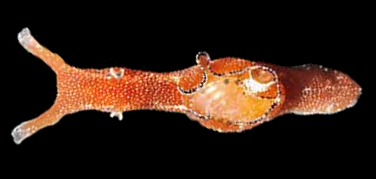|
Aplysia Juliana
''Aplysia juliana'', the walking sea hare, is a species of sea hare, a marine gastropod in the family Aplysiidae. Distribution Distribution of this species is cosmopolitan, circumtropical in all warm seas. Description This sea hare has no purple gland and therefore cannot produce ink, just milky secretions. The posterior end of the foot in this species can act as a sucker. The color of this sea hare is very often brown with paler spots, but it can be various other shades including plain black all over. The maximum recorded length is 300 mm.Welch J. J. (2010). "The "Island Rule" and Deep-Sea Gastropods: Re-Examining the Evidence". '' PLoS ONE'' 5(1): e8776. . ''A. juliana'' inhabits tidal pools and seagrass beds, to a depth of 20 metres. References Further reading * Bebbington A. (1974) ''Aplysiid species from East Africa with notes on the Indian Ocean Aplysiomorpha (Gastropoda: Opisthobranchia)''. Zoological Journal of the Linnean Society 54(1): 63-99. * Bebbington ... [...More Info...] [...Related Items...] OR: [Wikipedia] [Google] [Baidu] |
Jean René Constant Quoy
Jean René Constant Quoy (10 November 1790 in Maillé, Vendée, Maillé – 4 July 1869 in Rochefort, Charente-Maritime, Rochefort) was a French naval surgeon, zoologist and anatomist. In 1806, he began his medical studies at the school of naval medicine at Rochefort, Charente-Maritime, Rochefort, afterwards serving as an auxiliary-surgeon on a trip to the Antilles (1808–1809). After earning his medical doctorate in 1814 at Montpellier, he was surgeon-major on a journey to Réunion (1814–1815). Along with Joseph Paul Gaimard, he served as naturalist and surgeon aboard the ''Uranie'' under Louis de Freycinet from 1817 to 1820, and on the ''French ship Astrolabe (1817), Astrolabe'' (1826–1829) under the command of Jules Dumont d'Urville. In July 1823 he and Gaimard presented a paper to the Académie royale des Sciences on the origin of coral reefs, taking issue with the then widespread belief that these were constructed by coral polyps from bases in very deep water and arguin ... [...More Info...] [...Related Items...] OR: [Wikipedia] [Google] [Baidu] |
Joseph Paul Gaimard
Joseph Paul Gaimard (31 January 1793 – 10 December 1858) was a French naval surgeon and naturalist. Biography Gaimard was born at Saint-Zacharie on January 31, 1793. He studied medicine at the naval medical school in Toulon, subsequently earning his qualifications as a naval surgeon. Along with Jean René Constant Quoy, he served as naturalist on the ships ''L'Uranie'' under Louis de Freycinet 1817–1820, and '' L'Astrolabe'' under Jules Dumont d'Urville 1826–1829.Google Books Discovery of Australia's Fishes: A History of Australian Ichthyology to 1930 by Brian Saunders During this voyage they discovered the now extinct giant of |
Frederick Hutton (scientist)
Captain Frederick Wollaston Hutton (16 November 1836 – 27 October 1905) was an English-New Zealand scientist who applied the theory of natural selection to explain the origins and nature of the natural history of New Zealand. An army officer in early life, he then had an academic career in geology and biology. He became one of the most able and prolific nineteenth century naturalists of New Zealand. Biography Hutton was born in Gate Burton, Lincolnshire, England, the son of the Rev. Henry Frederick Hutton and his wife Louisa Wollaston, daughter of the Rev. Henry John Wollaston. He passed through Southwell grammar school and the Naval Academy at Gosport, Hampshire. He studied applied science at King's College London before being commissioned in the Royal Welch Fusiliers and fighting in the Crimean War and the Indian Mutiny. Hutton returned to England in 1860, and continued to study geology at Sandhurst, being elected to the Geological Society of London in the same ... [...More Info...] [...Related Items...] OR: [Wikipedia] [Google] [Baidu] |
Species
In biology, a species is the basic unit of classification and a taxonomic rank of an organism, as well as a unit of biodiversity. A species is often defined as the largest group of organisms in which any two individuals of the appropriate sexes or mating types can produce fertile offspring, typically by sexual reproduction. Other ways of defining species include their karyotype, DNA sequence, morphology, behaviour or ecological niche. In addition, paleontologists use the concept of the chronospecies since fossil reproduction cannot be examined. The most recent rigorous estimate for the total number of species of eukaryotes is between 8 and 8.7 million. However, only about 14% of these had been described by 2011. All species (except viruses) are given a two-part name, a "binomial". The first part of a binomial is the genus to which the species belongs. The second part is called the specific name or the specific epithet (in botanical nomenclature, also sometimes i ... [...More Info...] [...Related Items...] OR: [Wikipedia] [Google] [Baidu] |
Sea Hare
The clade Anaspidea, commonly known as sea hares (''Aplysia'' species and related genera), are medium-sized to very large opisthobranch gastropod molluscs with a soft internal shell made of protein. These are marine gastropod molluscs in the superfamilies Aplysioidea and Akeroidea. The common name "sea hare" is a direct translation from la, lepus marinus, as the animal's existence was known in Roman times. The name derives from their rounded shape and from the two long rhinophores that project upward from their heads and that somewhat resemble the ears of a hare. Taxonomy Many older textbooks and websites refer to this suborder as "Anaspidea". The original author Paul Henri Fischer described the taxon Anaspidea at unspecified rank above family. In 1925 Johannes Thiele established the taxon Anaspidea as a suborder. 2005 taxonomy Since the taxon Anaspidea was not based on an existing genus, this name is no longer available according to the rules of the ICZN. Anaspidea ha ... [...More Info...] [...Related Items...] OR: [Wikipedia] [Google] [Baidu] |
Marine (ocean)
The ocean (also the sea or the world ocean) is the body of salt water that covers approximately 70.8% of the surface of Earth and contains 97% of Earth's water. An ocean can also refer to any of the large bodies of water into which the world ocean is conventionally divided."Ocean." ''Merriam-Webster.com Dictionary'', Merriam-Webster, |
Gastropod
The gastropods (), commonly known as snails and slugs, belong to a large taxonomic class of invertebrates within the phylum Mollusca called Gastropoda (). This class comprises snails and slugs from saltwater, from freshwater, and from land. There are many thousands of species of sea snails and slugs, as well as freshwater snails, freshwater limpets, and land snails and slugs. The class Gastropoda contains a vast total of named species, second only to the insects in overall number. The fossil history of this class goes back to the Late Cambrian. , 721 families of gastropods are known, of which 245 are extinct and appear only in the fossil record, while 476 are currently extant with or without a fossil record. Gastropoda (previously known as univalves and sometimes spelled "Gasteropoda") are a major part of the phylum Mollusca, and are the most highly diversified class in the phylum, with 65,000 to 80,000 living snail and slug species. The anatomy, behavior, feeding, and re ... [...More Info...] [...Related Items...] OR: [Wikipedia] [Google] [Baidu] |
Aplysiidae
Aplysiidae is the only family in the superfamily Aplysioidea, within the clade Anaspidea. These animals are commonly called sea hares because, unlike most sea slugs, they are often quite large, and when they are underwater, their rounded body shape and the long rhinophores on their heads mean that their overall shape resembles that of a sitting rabbit or hare. Sea hares are however sea snails with shells reduced to a small plate hidden between the parapodia, and some species are extremely large. The Californian black sea hare, ''Aplysia vaccaria'' is arguably the largest living gastropod species, and is certainly the largest living heterobranch gastropod. Description Members of the Aplysiidae have an atrophied inner shell (in contrast with the nudibranchs, which have no shell at all). In ''Aplysia'' and ''Syphonota'', this shell is a soft flattened plate over the visceral rear end, where it is fully or partially enclosed in the mantle skin. In ''Dolabella auricularia'', t ... [...More Info...] [...Related Items...] OR: [Wikipedia] [Google] [Baidu] |
Cosmopolitan Distribution
In biogeography, cosmopolitan distribution is the term for the range of a taxon that extends across all or most of the world in appropriate habitats. Such a taxon, usually a species, is said to exhibit cosmopolitanism or cosmopolitism. The extreme opposite of a cosmopolitan species is an endemic one, being found only in a single geographical location. Qualification The caveat “in appropriate habitat” is used to qualify the term "cosmopolitan distribution", excluding in most instances polar regions, extreme altitudes, oceans, deserts, or small, isolated islands. For example, the housefly is highly cosmopolitan, yet is neither oceanic nor polar in its distribution. Related terms and concepts The term pandemism also is in use, but not all authors are consistent in the sense in which they use the term; some speak of pandemism mainly in referring to diseases and pandemics, and some as a term intermediate between endemism and cosmopolitanism, in effect regarding pandemism as ... [...More Info...] [...Related Items...] OR: [Wikipedia] [Google] [Baidu] |
Aplysia
''Aplysia'' () is a genus of medium-sized to extremely large sea slugs, specifically sea hares, which are one clade of large sea slugs, marine gastropod mollusks. These benthic herbivorous creatures can become rather large compared with most other mollusks. They graze in tidal and subtidal zones of tropical waters, mostly in the Indo-Pacific Ocean (23 species); but they can also be found in the Atlantic Ocean (12 species), with a few species occurring in the Mediterranean. ''Aplysia'' species, when threatened, frequently release clouds of ink, it is believed in order to blind the attacker (though they are in fact considered edible by relatively few species). Following the lead of Eric R. Kandel, the genus has been studied as a model organism by neurobiologists, because its gill and siphon withdrawal reflex, as studied in ''Aplysia californica'', is mediated by electrical synapses, which allow several neurons to fire synchronously. This quick neural response is necessary f ... [...More Info...] [...Related Items...] OR: [Wikipedia] [Google] [Baidu] |







